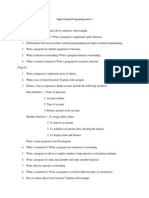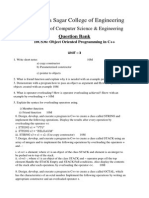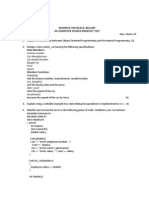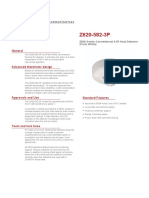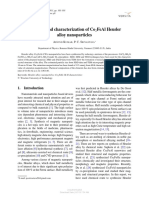0% found this document useful (0 votes)
62 views2 pagesC++ Test3 2009
The document provides sample questions and answers for an object-oriented programming exam in C++. It includes two sections - Section A with multiple choice questions worth 4 marks each on topics like data encapsulation, virtual functions, abstract classes, polymorphism, and memory management. Section B includes longer form questions worth 5 marks each, including defining missing member functions for a Complex class and providing a complete class specification for a Length class with meters and centimeters private data.
Uploaded by
ravisankarmurugan217Copyright
© Attribution Non-Commercial (BY-NC)
We take content rights seriously. If you suspect this is your content, claim it here.
Available Formats
Download as DOC, PDF, TXT or read online on Scribd
0% found this document useful (0 votes)
62 views2 pagesC++ Test3 2009
The document provides sample questions and answers for an object-oriented programming exam in C++. It includes two sections - Section A with multiple choice questions worth 4 marks each on topics like data encapsulation, virtual functions, abstract classes, polymorphism, and memory management. Section B includes longer form questions worth 5 marks each, including defining missing member functions for a Complex class and providing a complete class specification for a Length class with meters and centimeters private data.
Uploaded by
ravisankarmurugan217Copyright
© Attribution Non-Commercial (BY-NC)
We take content rights seriously. If you suspect this is your content, claim it here.
Available Formats
Download as DOC, PDF, TXT or read online on Scribd
/ 2














